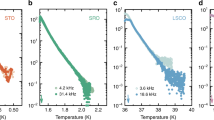Summary
Superconducting properties are conveniently divided into three groups. Primary properties are those, like Tc and Hc, that are relatively structure and composition-insensitive. Secondary properties are those, like Hc1 and Hc2, that are composition-sensitive through dependence on normal state resistivity. Primary and secondary properties are both equilibrium properties. Tertiary properties are non-equilibrium properties, like Ic and magnetic hysteresis, that are extremely structure-sensitive, being controlled by internal structural heterogeneities. The relationships among the various properties are shown schematically in Fig. 11.
The bulk critical currents in the mixed state, because of suggestive analogies to mechanical yield stresses and ferromagnetic coercive forces, seem most interesting to a physical metallurgist. Most of the standard ways of increasing hardness—cold work, precipitation, radiation damage, martensitic transformation—have already been shown to be effective in enhancing critical currents. However, these effects need more detailed understanding, and the effects of spinodal decomposition, internal oxidation, SAP-type processing, and various composite structures remain virtually unexplored.
The major role of physical metallurgists in superconductivity will be to improve our understanding of structure-properties relations, and thereby provide a basis for improved properties. However, it also seems likely that as this understanding of structure-properties relations grows, superconducting measurements will be used more and more as a tool to study metallurgical structure.
Similar content being viewed by others
References
J. D. Livingston and H. W. Schadler: Prog. Mater. Sci., 1964, vol. 12, pp. 183–287.
J. D. Livingston: Phys. Rev., 1963, vol. 129, pp. 1943–1949.
C. P. Bean: Rev. Mod. Phys., 1964, vol. 36, pp. 31–39.
W. W. Webb: Phys. Rev. Letters., 1963, vol. 11, pp. 191–193; R. L. Fleischer: Phys. Letters, 1962, vol. 3, pp. 111–112.
A. V. Narlikar and D. Dew-Hughes: Phys. Stat. Sol., 1964, vol. 6, pp. 383–390; D. Kramer and C. G. Rhodes: Trans. Met. Soc. AIME, 1965, vol. 233, pp. 192–198.
J. D. Livingston: Rev. Mod. Phys., 1964, vol. 36, pp. 54–57.
G. A. Beske. Sc.D. Thesis, 1965, Massachusetts Institute of Technology, Metallurgy Department.
J. Friedel, P. G. de Gennes, and J. Matricon: Appl. Phys. Letters, 1963, vol. 2, pp. 119–121.
P. D. Merica, R. G. Waltenberg, and H. Scott: Trans. AIME, 1921, vol. 64, pp. 41–77.
L. G. Dijkstra and C. Wert: Phys. Rev., 1950, vol. 79, pp. 979–985.
T. H. Alden and J. D. Livingston Appl. Phys. Letters, 1966, Vol. 8, pp. 6–7.
J. D. Livingston: J. Appl. Phys., 1963, vol. 34, pp. 3028–3036; Acta Met., 1963, vol. 11, pp. 1371–1373.
P. S. Swartz, H. R. Hart, Jr., and R. L. Fleischer: Appl. Phys. Letters, 1964, vol. 4, pp. 71–73; J. P. McEvoy, Jr., R. F. Decell, and R. L. Novak:Appl. Phys. Letters, 1964, vol. 4, pp. 43–45; G. W. Cullen and R. L. Novak: Appl. Phys. Letters, 1964, vol. 4, pp. 147–149.
C. P. Bean, R. L. Fleischer, P. S. Swartz, and H. R. Hart, Jr.: J. Appl. Phys., to be published.
J. D. Livingston: Final Report, 1965, Contract No. AF-33(657)-11722, BPSN 63-6899-737102, Wright-Patterson Air Force Base, Ohio.
S. A. Levy, R. W. Kraft, and Y. B. Kim: J. Appl. Phys., to be published.
D. Saint-James and P. G. DeGennes: Phys. Letters, 1963, vol. 7, pp. 306–308.
P. W. Anderson and Y. B. Kim: Rev. Mod. Phys., 1964, vol. 36, pp. 39–43.
Z. S. Basinski: Proc. Roy. Soc., 1957, vol. A240, pp. 229–242; Austral. J. Phys., 1960, vol. 13, pp. 354–358.
V. A. Phillips: Phil. Mag., 1965, vol. 11, pp. 775–797.
K. Mendelssohn: Proc. Roy. Soc., 1935, vol. A152, pp. 34–41; Cryogenics, 1963, vol. 3, pp. 129–140.
Author information
Authors and Affiliations
Rights and permissions
About this article
Cite this article
Livingston, J.D. Making superconductors hard. JOM 18, 698–704 (1966). https://doi.org/10.1007/BF03378458
Published:
Issue Date:
DOI: https://doi.org/10.1007/BF03378458




